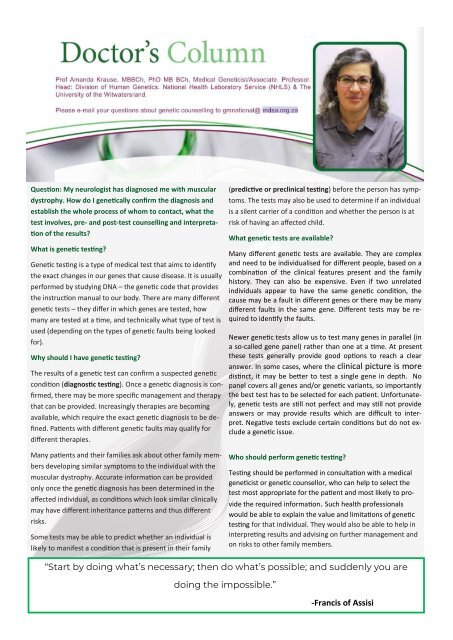MDF Magazine Issue 72 December 2023
You also want an ePaper? Increase the reach of your titles
YUMPU automatically turns print PDFs into web optimized ePapers that Google loves.
Question: My neurologist has diagnosed me with muscular<br />
dystrophy. How do I genetically confirm the diagnosis and<br />
establish the whole process of whom to contact, what the<br />
test involves, pre- and post-test counselling and interpretation<br />
of the results?<br />
What is genetic testing?<br />
Genetic testing is a type of medical test that aims to identify<br />
the exact changes in our genes that cause disease. It is usually<br />
performed by studying DNA – the genetic code that provides<br />
the instruction manual to our body. There are many different<br />
genetic tests – they differ in which genes are tested, how<br />
many are tested at a time, and technically what type of test is<br />
used (depending on the types of genetic faults being looked<br />
for).<br />
Why should I have genetic testing?<br />
The results of a genetic test can confirm a suspected genetic<br />
condition (diagnostic testing). Once a genetic diagnosis is confirmed,<br />
there may be more specific management and therapy<br />
that can be provided. Increasingly therapies are becoming<br />
available, which require the exact genetic diagnosis to be defined.<br />
Patients with different genetic faults may qualify for<br />
different therapies.<br />
Many patients and their families ask about other family members<br />
developing similar symptoms to the individual with the<br />
muscular dystrophy. Accurate information can be provided<br />
only once the genetic diagnosis has been determined in the<br />
affected individual, as conditions which look similar clinically<br />
may have different inheritance patterns and thus different<br />
risks.<br />
Some tests may be able to predict whether an individual is<br />
likely to manifest a condition that is present in their family<br />
(predictive or preclinical testing) before the person has symptoms.<br />
The tests may also be used to determine if an individual<br />
is a silent carrier of a condition and whether the person is at<br />
risk of having an affected child.<br />
What genetic tests are available?<br />
Many different genetic tests are available. They are complex<br />
and need to be individualised for different people, based on a<br />
combination of the clinical features present and the family<br />
history. They can also be expensive. Even if two unrelated<br />
individuals appear to have the same genetic condition, the<br />
cause may be a fault in different genes or there may be many<br />
different faults in the same gene. Different tests may be required<br />
to identify the faults.<br />
Newer genetic tests allow us to test many genes in parallel (in<br />
a so-called gene panel) rather than one at a time. At present<br />
these tests generally provide good options to reach a clear<br />
answer. In some cases, where the clinical picture is more<br />
distinct, it may be better to test a single gene in depth. No<br />
panel covers all genes and/or genetic variants, so importantly<br />
the best test has to be selected for each patient. Unfortunately,<br />
genetic tests are still not perfect and may still not provide<br />
answers or may provide results which are difficult to interpret.<br />
Negative tests exclude certain conditions but do not exclude<br />
a genetic issue.<br />
Who should perform genetic testing?<br />
Testing should be performed in consultation with a medical<br />
geneticist or genetic counsellor, who can help to select the<br />
test most appropriate for the patient and most likely to provide<br />
the required information. Such health professionals<br />
would be able to explain the value and limitations of genetic<br />
testing for that individual. They would also be able to help in<br />
interpreting results and advising on further management and<br />
on risks to other family members.<br />
“Start by doing what’s necessary; then do what’s possible; and suddenly you are<br />
doing the impossible.”<br />
-Francis of Assisi

















